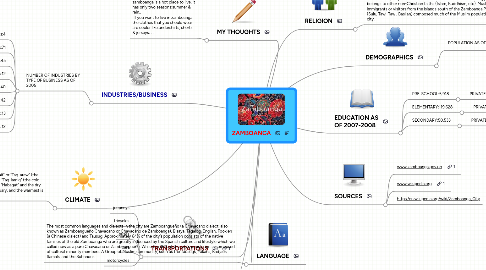ZAMBOANGA
par carl manantan


1. INDUSTRIES/BUSINESS
1.1. NUMBER OF INDUSTRIES BY TYPE OF BUSINESS AS OF 2005
1.1.1. textiles:4
1.1.2. garments:71
1.1.3. woods:45
1.1.4. metals:12
1.1.5. furnitures:40
1.1.6. machine/equipment:42
1.1.7. electrical and transport:13
1.1.8. others:12
2. TRANSPORTATIONS
2.1. jeepneys
2.2. tricycles
2.3. buses
2.4. cars
2.5. motorcycles
3. MY THOUGHTS
3.1. zamboanga is a hot place to live, it has only two seasons:summer & rain.. If you want to live in zamboanga the clothes that you should wear are cooler like:undershirts, shorts & jerseys. . .
4. LANGUAGE
4.1. The most common languages and dialects in the city are Zamboangueño (a Chavacano dialect, also known as Zamboangueño Chavacano or Chavacano de Zamboanga), Bisaya, Tagalog, English, Fookien (a Chinese dialect) and Tausug. Approximately 64% of the city’s population consists of the native families of the old Zamboanga who are greatly influenced by the Spanish culture and lifestyle which we called now as a pure Chavacano or Zamboangueño. While the 36% of the city’s population is composed of cultural minority members. A Group of Muslim community, such us the Tausugs, Yakans, Badjaos, Samals, and the Subanons.
5. CLIMATE
5.1. The average yearly temperature is around 26.5°C (79.7°F). There are three recognized seasons: "Tag-init" or "Tag-araw" (the hot season or summer from March to May), "Tag-ulan" (the rainy season from June to November), and "Tag-lamig" (the cold season from December to February). The southwest monsoon (from May to October) is known as the "Habagat" and the dry winds of the northeast monsoon (from November to April) as the "Amihan". The coolest month is January, and the warmest is May. Both temperature and humidity levels reach the maximum in April and May
6. SPORTS & RECREATION
6.1. Various sports are played in the Philippines including basketball, boxing, volleyball, badminton, billiards, football (soccer), ten-pin bowling and sipa. Traditional Filipino sports are popular,[146][147] among the youth, primarily as children's games, such as luksung baka, patintero, piko, and tumbang preso. Sungka, while not as popular as it once was, is still viewed as a significant part of the traditional native Filipino games. Card games are popular during festivities, with some, including Pusoy and Tong-its, being used as a form of illegal gambling. Majhong is played in some Filipino communities.
7. DEMOGRAPHICS
7.1. POPULATION AS OF 1990-2007
7.1.1. 1990
7.1.1.1. 442,345
7.1.2. 1995
7.1.2.1. 511,139
7.1.3. 2000
7.1.3.1. 601,794
7.1.3.1.1. MALE:302,089
7.1.3.1.2. FEMALE:299,705
7.1.4. 2007
7.1.4.1. 774,407
8. SOURCES
8.1. www.zamboanga.gov.ph
8.2. www.wikipedia.org
8.3. http://en.wikipedia.org/wiki/Zamboanga_City
9. EDUCATION AS OF 2007-2008
9.1. PRE-SCHOOL:5,918
9.1.1. PRIVATE:2,274
9.1.1.1. GOV.:3,644
9.2. ELEMENTARY:119,628
9.2.1. PRIVATE:4,738
9.2.1.1. GOV.:114,890
9.3. SECONDARY:50,533
9.3.1. PRIVATE:6,670
9.3.1.1. GOV.:43,863
